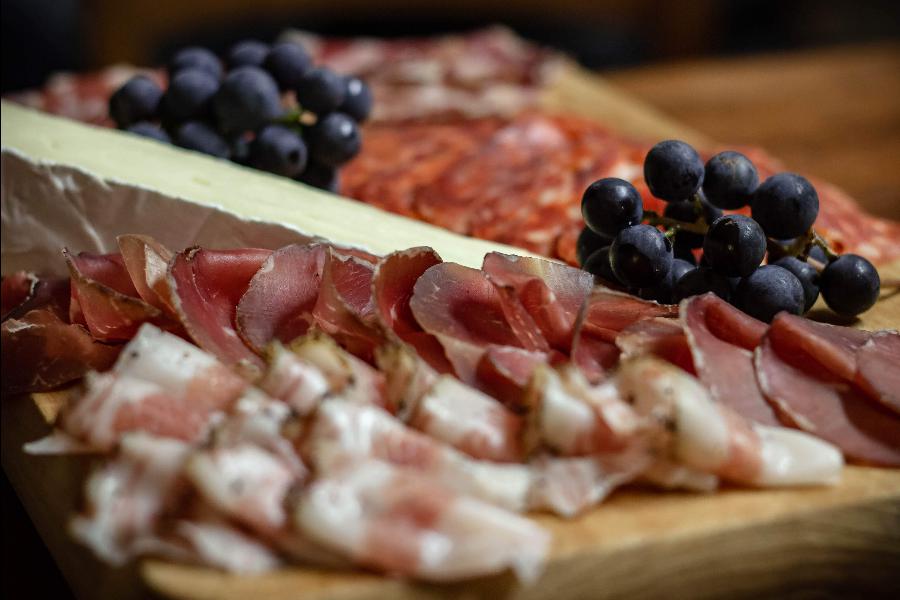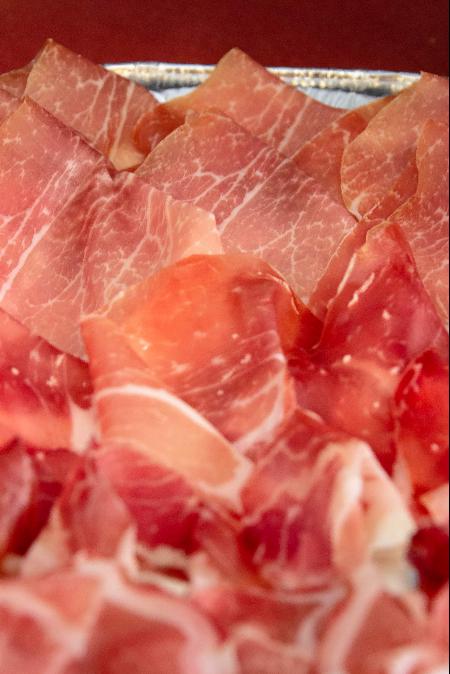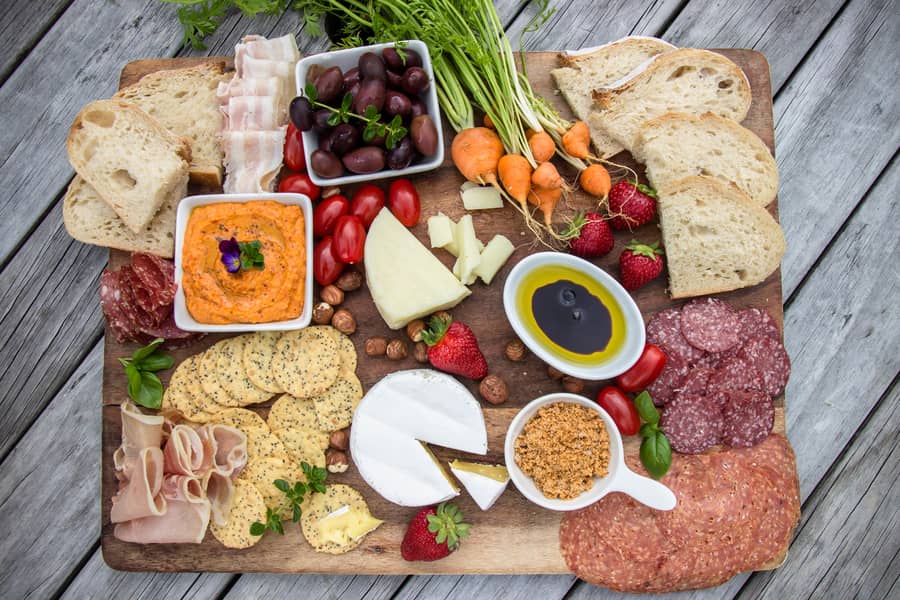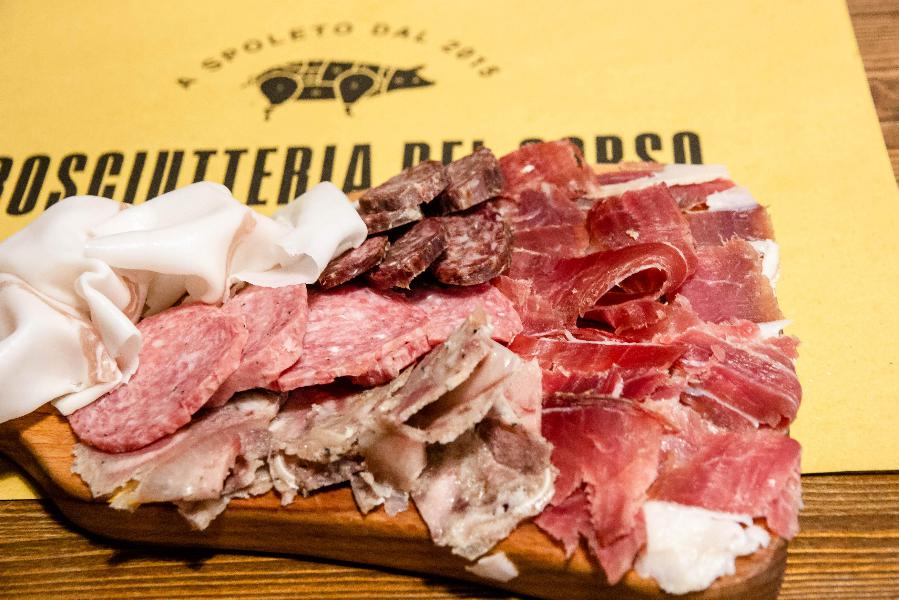I have had hundreds of variations of these appetizer platters, and I’ve enjoyed variations of them across all regions of Italy.
Antipasto is singular and refers to one portion. Antipasti is plural and refers to multiple portions. Antipasta is a misinterpretation of the Italian language and has no official meaning.
Since antipasti and antipasto are associated with cured meats and salumi.
Antipasta does not mean anything since it’s a modern spelling error for those who do not understand the Italian language.
This often needs clarification outside of Italy. As a purveyor of antipasti, salumi, salami, and charcuterie, I’ll explain all this in detail as well as some insights into the tradition.
Key Points:
- Antipasti Tradition: These appetizers typically feature cured meats, cheeses, and preserved vegetables.
- Cultural Significance: Antipasti symbolizes sharing and connection before a meal, akin to the old biblical tradition of “breaking bread.”
- Italian Meal Structure: Antipasti is just the beginning of a traditional Italian meal, followed by primo, secondo, contorno, dolce, and caffe (For a formal Italian Meal).
Charcuterie is a modern word for what was called an ‘appetizer’ or meat & cheese platter in the 1980s.
Rather than just defining the difference, let’s explore what a classic interpretation is and fully educate you on this topic.
Insights into Antipasti, Antipasto & Antipasta

Antipasto and Antipasti translate to ‘pre-meal‘ (wiki link here). They almost always include cured meats, cheeses, and preserved vegetables.
Antipasto is ‘singular’, referring to one portion. Antipasti is ‘plural’, which refers to more than one.
Antipasta is a misinterpretation of the Italian language and doesn’t mean anything, yes I got it wrong for a long time!
Why Antipasti/Antipasto

The old biblical term for ‘breaking bread’ parallels the antipasti enjoyed in Italy and throughout the world today.
Sharing to ‘Break the Ice’
When I think about sharing, it’s all about sharing at the start of the meal—if you’re sharing something together, you feel more connected to the people you’re with, rather than having your plate of food to guard and eat individually.
In English, Antipasti/Antipasto is an ‘Appetizer’
It’s probably the easiest way to think about it or the easiest way for me to think about it.
It is a shared appetizer at the start of the meal. Many of the Italian antipasto experiences we have had are so big that we are pretty much complete after the appetizer. Italians know how to eat big!
Or if you’re going to a bar for an apertivo (tapa-style, but Italian drink with often appetizers for free) light food that comes out with a hopefully slightly more expensive drink before a full dinner.
Again, we had aperitivo’s that filled us up for the night!
Formal Breakdown Italian Courses
Antipasto is a singular word referring to one. In Italian, there are masculine and feminine words, so antipasto is masculine.
Antipasti is plural – more than one.
Antipasta is when people miss hearing the word or do not understand Italian.
Pasto in Italian means meal, and anti-, when translated, is before; therefore, antipasto means,
“before the meal“
Other names for Antipasti
In the modern context, across a lot of the world, charcuterie platter or board is used, and it’s probably a little bit different since you’ll find crackers, fruit, pesto, spreads, chutney, and many other editions – in the modern context.

You are, however, highly unlikely to find any of this on antipasto (here is an article on cured meats for classic antipasto) boards in Italy (maybe in Rome or another big city, though). I wrote another post about traditional French and Italian pre-meal appetizer boards; check out that post here.
Confusion with Pasta & Antipasta
Another theory that floats around is the word pasta, which is very Italian; one knows that pasta ends with an a. It kind of makes sense that anti-pasta is ‘o’.
What to Put on an Antipasti or Antipasto Board/Platter
Here are some of my favorites and also some of the classics.
A video helped, as an Italian showcases Antipasti styles in a traditional way:
Before I go into list mode, I want to highlight what I always see in Italy.
A regional prosciutto was often served in an antipasti at somebody’s house or restaurant. (dry-cured whole leg of quality pork – usually finished on nuts and whey – hopefully, with 12 months minimum of drying).

Parma Ham is from Parma (yes, I stayed in Parma, visited Parma factories, and ate my share of Parma in Parma). Parma is a light, slightly sweet prosciutto protected by European law, and they make sure the pigs, quality, and process have been adhered to in a strictly traditional manner. Here is a link that explains it way better than me: DOP (in Italian) or PDO (Protected Designation of Origin) in English.
I can eat Parma until the preverbal “cows (or pigs) come home”; it’s what I would call session salumi. I heard the term “session” concerning craft beer and copied it.
Salumi (Which Includes Salami), Cured Meat
If you want to make or buy some of these, I will include a few links to guide you to decent resources. Either I have written about it, or I can send you down the right track to order/eat or even make it yourself!
Classic Dry Cured Meat for an Antipasti Platter
| Prosciutto (Dry Cured Pork Leg) | Dry Cured Salami |
| Braesola (Dry Cured Beef) | Pancetta (Dry Cured Pork Belly) |
| Coppa (Dry Cured Upper Loin Neck Pork) | Mortadella (Emulsified salami) |
Cheeses and Marinated Vegetables
- Marinated Olives (in Extra Virgin Olive Oil)
- Here is a great quick recipe
- I found this authentic supplier – buy here
- Preserved Courgettes (in Extra Virgin Olive Oil (not pickled)
I am, of course, always keen for variation, and the spice of life is, of course, trying new things. But specifically, I am all for the classics now and then as well.
History of Antipasti
I have read that it dates back to medieval Europe, specifically Italy. I need to read more to grasp a deeper understanding of the history surrounding this.
Regional Variations of Antipasti
Northern Italy
Regions across northern Italy, namely Austria, overlap, which lends it a taste slightly more toward Central Europe.
However, it’s an area I need to explore more. Here are some examples I see across Northern Italy:
- Classic Basil Pesto
- Prosciutto de Parma
- Olive Tapenade
Around Parma in the Emilia-Romagna region, food culture is prolific, with the province of Modena and the ‘real’ balsamic, which is DOP and comes in 12 or 25-year bottles.
We did experience with a fantastic Italian man, I was lucky enough to taste a 50-year-old authentic Modena Balsamic that his father started when the son was born.
Here is further information on the protected ‘true’ traditional vinegar I brought back from Italy and gave to a close friend. To be real, Modena balsamic, the shape of the bottle can only be this.
Then, of course, cullatello and felino salami spring to mind – all from the same region.
12-month minimum (to 5 years) DOP Parmigiano-Reggiano is also born in this region. Astonishing really.
Central Italy
Umbria / Tuscany

They are very different but quite similar in ways. I had all sorts of delicious cinghiale (wild boar – pronounced ‘shing-gaal-lee’) variations of cured meat and salumi in Umbria.
- Gorgonzola cheese (fantastic Italian blue cheese)
- Fresh fennel
- seafood and cured meats of Tuscany (Tuscany has it all!)
Southern Italy
The spicy influence of Africa and seafood surrounding the area come to party on the plate around here!
- Njuda – a spreadable salami of pork meat, pork fat, and Calabrian chillis (I left the area recently with 4 pounds of it from a home producer with pigs for friends and family!)
- Burrata – Think Mozzarella with rich cream inside
- Buffalo Mozzarella DOP
- Preserved Seafood – like white anchovies and pickled octopus (especially in the Puglia region)
Sicily (it’s an Island South)
Sicily is considered to be in contrast to mainland Italy. The home of the Godfather and the Mafia, Sicily is a unique and fascinating place. I have only visited once for three weeks, driving around the coast.
Seafood is king, and the African influences come out. Antipasti is very ocean-orientated, from my experiences.
Traditional Italy Meal Course
So many formal dinners, or even informal I have had in Italy or with Italians have had the entire progression of course, which is:
Aperitivo: a small dose of liqueur enjoyed before the meal, like Prosecco or Campari.
The antipasto: A traditional Italian meal starts with something to nibble on, called an antipasto, which translates into English as “before the meal.” It can include hot and cold appetizers like cheese, sopprasatta, bread, and dressed vegetables.
The primo: In Italy, pasta is a first course, or primo, served as an appetizer, not as the main event. Soup, rice, and polenta are the other options for the primo.
The secondo: The main course is called il secondo, or the second course. Chicken, meat, or fish are the usual choices, and portions are generally small. These main courses are usually fairly simple, especially if a rich pasta or rice dish precedes them.
The contorno: A platter of vegetables usually accompanies the main course. This side dish highlights the simple goodness of the vegetable.
The dolce: A dolce (or sweet) ends a traditional Italian meal.
Caffe: coffee and its permutations. A must with the dolce.
Digestivo: a “digestive” or after dinner liqueur like grappa and limoncello
THE CLASSIC ITALIAN MEAL STRUCTURE – http://www.speakitalian.org/the-classic-italian-meal-structure.html
Resources for Antipasti and Antipasto
Over and above the author’s knowledge of the subject, these resources are also cited as research into this to clarify the information.
https://en.wikipedia.org/wiki/Antipasto
https://www.delallo.com/blog/antipasti-meal-social-gathering-or-both/

Tom Mueller
For decades, immersed in studying, working, learning, and teaching the craft of meat curing, sharing the passion and showcasing the world of charcuterie and smoked meat. Read More
